Barrier Oil
-
- New Offshore Environmental Lubricant Marine Technology, Jan 2014 #22
During the OTC Brazil 2013 in Rio de Janeiro, MTR’s correspondent Claudio Paschoa met with Chris Morrissey, who is Team Leader in Energy Lubricant Development for Castrol in the UK, and Carmen Pino, Regional Sales Director for Castrol Offshore for a chat about the new Environmental Lubricant being developed by Castrol Offshore with the support of OneSubsea. This barrier oil provides extreme thermal stability, good electrical insulation and lubricity, and fully meets the tightest OSPAR environmental legislation
The O&G industry is increasingly targeting deepwater plays, where subsea equipment such as pumps, manifolds and Xmas trees are constantly under high pressure, be it the water pressure at depths that may exceed 2,000m or high pressure from the reservoir itself. There is also the heat coming from the reservoir and the cold from the deep ocean waters which may affect subsea equipment.
Most subsea equipment uses some form of lubricating oil, which is used to lubricate hydrodynamic bearings, mechanical seals and other internal components, but also acts as cooling medium in motor, pump or compressor components. Lubricants additionally keep certain insulation properties in motor and power penetrators, along with transporting wear particles to filters and acting as a barrier between sea/process and internal components. “There were a couple of main drivers in developing the new lubricant. One was the need for environmentally enhanced lubricants, because the traditional kinds lubricants used for subsea applications at the moment do not meet the tighter environmental legislation being introduced, so we wanted to develop a product, which was fully compliant to the stringent environmental legislation in the North Sea. Then, through this development, it became clear that there was a need to extend the performance of the lubricant in order to reach thermal stability requirements. The current conventional lube stars to break down at 100 °C and we managed to extend the thermal stability of the new lube to 220 °C,” said Morrissey. The development of a enhanced lubricating oil is a long process, which involves identifying raw materials, formulation screening and the optimization of additives long before any rig or equipment testing is done. “When we started out we didn’t really know what we could achieve with the environmental lube, so there was a bit of a challenge there. The typical additives used in standard lube oils don’t pass the environmental legislation tests, so we had to search for new chemicals, new additives, new building blocks,” said Morrissey.
The major testing in the development stage involves thermal stability testing, TAN variation testing, fluid drying test with coalescing filter and motor insulation compatibility testing, all of which are done at Castrol’s Technology Center in Pangbourne, near Reading, west of London. “We have development centers all over the world, but for energy and more specifically for subsea, Pangbourne is where it happens,” said Morrissey. “The development work with OneSubsea has been going on for seven years now. We build a collaborative relationship with OneSubsea knowing it would take a bit of time to get through this development, in order to go through all the improvement testing and so on. The key thing in this industry is that everyone wants to know that the product is absolutely going to work and that takes a long time.”
Also according to Morrissey, the finished product should be ready to go to the market by mid 2014 and the launching location is still uncertain.
“The way we run our organization, we may choose a specific region to launch it but in general cases, especially with the level of certainty we have in the product, we can globally launch pretty seamlessly throughout the organization,” said Pino. Since the lubricant was conceived to pass the North Sea environmental legislation, there is a good possibility that it will be first launched in the North Sea, however Morrissey quickly pointed out that “We have to figure out where the first unit using the lube will be delivered and then support it in that region first, as a priority.”
There are certainly important advantages offered by the new product, and with the enormous growth that is occurring in the subsea industry these advantages may become an important deferential for players and equipment manufacturers to embrace Castrol’s environmental lubricant.
“We are quite excited about two key areas where we see that the new lube has great advantage. One is the demand for this kind of lube from locations where field conditions are really hot and the other is use of the lube in subsea boosting and compression equipment, where OneSubsea is getting to the end of development testing in the use of the lube in its subsea wet gas compressor. Up to now testing has indicated that this lube is ideal for the requirements of this technology. Subsea boosting and compression technology is increasingly being used in deepwater fields as it offers increased operational flexibility, while at the same time bringing some of the surface production equipment to the seafloor. This technology has proven to bring advantages, such as increased production, recovery and flow assurance. Yet some of the equipment requires a lubricant oil with high thermal rating in order to increase performance and reliability.
Depending on the location where the equipment will be used, there may also be a requirement to comply with specific environmental legislation.
“Thermal stability is really the key aspect of the product, along with the controlled amount of additives used. When we look at the mechanical seals for example, these run at high speeds, creating a pressure differential, which generates a lot of heat. If the lubricant breaks down at high temperatures you get deposits building up on the face of the seals which may cause long term reliability issues. You don’t want anything flaking out across those surfaces, you want them to remain absolutely clean and in order to attain that you need a lube with a high thermal stability and a perfectly balanced additive count, because additives can drop out of the fluid and cause lacquering of the seal face”, said Morrissey.
Castrol is a global company and as such they have many options on how to market the new product.
“I think there are two elements we need to take into consideration when marketing this product. First there is the equipment and project we know of today, where we will be working collaboratively with the technical departments, receiving direct feedback on the product. There is also a more interesting part, where we try to discover in what other applications the lubricant can be used, for instance, thrusters and well capping may benefit from this kind of lubricant, the potential is huge and that’s where our global organization will come into play,” said Pino.
Facts about the new Environmental Lubricant
• Performance assurance has been achieved by benchmarking the fluid through testing against existing lubricants of known performance and track record,
• An alternative environmental oil solution, which has little or no additional risk to reliability, and with the benefits of higher performance,
• Further rig testing and real life machine running hours will ensure maximum confidence before launch,
• For wet gas compressor the contra-rotating seal tests and full compressor trial are planned, with TRL4 to be reached by March 2014,
• Next steps for the hot pump development (400F/ 204C) is to qualify the elastomers/polymers over a wide temperature range for extended periods,
• Market demand for larger capacity machines will push performance limits of the barrier oil.
(As published in the January/February 2014 edition of Marine Technology Reporter - www.seadiscovery.com) -
- USCG A w a r d s Contract To O f f s h o r e Devices For O i l Spill Recovery System Maritime Reporter, Jun 1980 #62
is based on four workboats 30 feet long by 8 feet wide, each having a separate function. Provided with the system are the following: containment barrier, self-adjusting weir skimming barrier, oil-water gravity separator, 250-gpm double-acting diaphragm pump, and oil storage capability. The boats
-
- Great Ships of 2 0 0 1 Maritime Reporter, Dec 2001 #26
a launching platform, supplied by Llalco • Service boat with outboard motor Marine Aries pollution cleanup kit formed by: 300 m oil spill contention barrier Oil skimmer Waste transfer pump Also arranged on board is a Skum monitor to provide firefighting service to other ships Propulsion and Maneuvering Iz
-
 )
March 2024 - Marine Technology Reporter page: 42
)
March 2024 - Marine Technology Reporter page: 42NEW TECH OCEANOLOGY INTERNATIONAL 2024 Image courtesy Greg Trauthwein Image courtesy BIRNS MacArtney launches the new ultra-compact ø12.7 mm SubConn Nano connector. Innovative connectivity built on 45 years of ? eld-proven and market-trusted design. Image courtesy MacArtney Birns celebrated its 70th
-
 )
March 2024 - Marine Technology Reporter page: 39
)
March 2024 - Marine Technology Reporter page: 39Photo courtesy Global Ocean Design Figure 7 A 35Ah AGM lead-acid battery is tested using the West Mountain Radio CBA to show the effect of simply ? lling the battery voids with mineral oil as a compensating ? uid. The CBA is programmed to cut-off at a voltage of 10.50v. The top line (red) shows the
-
 )
March 2024 - Marine Technology Reporter page: 37
)
March 2024 - Marine Technology Reporter page: 37miscible barrier ? uid heavier than seawater (sg=1.026) and lighter than the battery electrolyte (sg=1.265). The original cell vent cap was screwed into the top of the riser pipe to vent the gases associated with charging. Wires were soldered to the lead (Pb) posts. The lead-acid battery was additionall
-
 )
March 2024 - Marine Technology Reporter page: 36
)
March 2024 - Marine Technology Reporter page: 36LANDER LAB #10 Of special interest for marine applications, LiPo batteries are Shipping any kind of lithium battery can be a challenge, and offered in a “pouch” design, with a soft, ? at body. The pouch IATA regs vary with the batteries inside or outside an instru- is vacuum-sealed, with all voids ?
-
 )
March 2024 - Marine Technology Reporter page: 35
)
March 2024 - Marine Technology Reporter page: 35Figure 1 A self-righting vehicle design with buoyancy high and weight low, WHOI’s SeaBED AUV captures the attention of a pair of curious Antarctic penguins as it is deployed from the British research vessel James Clark Ross. Vehicle designers allowed for temperature reduction of battery capacity. Recharge
-
 )
March 2024 - Marine Technology Reporter page: 33
)
March 2024 - Marine Technology Reporter page: 33regulated industry in the world.” How- ever, commercial success depends on many factors, not least a predictable OPEX. Over the past four years, SMD has worked with Oil States Industries to calculate cost per tonne ? gures for prospective customers. Patania II uses jet water pumps to Oil States’
-
 )
April 2024 - Maritime Reporter and Engineering News page: 47
)
April 2024 - Maritime Reporter and Engineering News page: 47MARKETPLACE Products & Services www.MaritimeEquipment.com Powering the fleet for 60 years! HYDRAULIC NOISE, SHOCK AND VIBRATION SUPPRESSOR Noise, Shock, VibraO on & PulsaO on in Quiet, Smooth Flow Out Oil Bladder Nitrogen (blue) Manufactured by MER
-
 )
April 2024 - Maritime Reporter and Engineering News page: 41
)
April 2024 - Maritime Reporter and Engineering News page: 41Nautel provides innovative, industry-leading solutions speci? cally designed for use in harsh maritime environments: • GMDSS/NAVTEX/NAVDAT coastal surveillance and transmission systems • Offshore NDB non-directional radio beacon systems for oil platform, support vessel & wind farm applications
-
 )
April 2024 - Maritime Reporter and Engineering News page: 38
)
April 2024 - Maritime Reporter and Engineering News page: 38Tech Files Latest Products, Systems and Ship Designs Zero-Emission Mooring Service of a Tanker Consulmar achieved a milestone by executing what it calls ing boat Castalia, which operates on full electric propulsion. the world's ? rst zero-emissions mooring service for a tanker. Equipped with two 150 kW
-
 )
April 2024 - Maritime Reporter and Engineering News page: 35
)
April 2024 - Maritime Reporter and Engineering News page: 35SIMULATION e have a close relationship with tech- Realism is prized beyond immersive, photo-realistic visu- nology, evidenced by, for example, als, and providers are introducing increasingly accurate func- the phones we are estimated to un- tionality. FORCE Technology’s upcoming DEN-Mark2 math- lock around
-
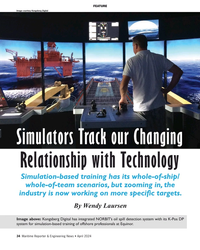 )
April 2024 - Maritime Reporter and Engineering News page: 34
)
April 2024 - Maritime Reporter and Engineering News page: 34FEATURE Image courtesy Kongsberg Digital Simulators Track our Changing Relationship with Technology Simulation-based training has its whole-of-ship/ whole-of-team scenarios, but zooming in, the industry is now working on more speci? c targets. By Wendy Laursen Image above: Kongsberg Digital has integrated
-
 )
April 2024 - Maritime Reporter and Engineering News page: 32
)
April 2024 - Maritime Reporter and Engineering News page: 32FEATURE A closeup of a blade installation process taken via drone. A blade handling system is apparent (in yellow). Images courtesy of Mammoet requirement for the development of these cranes, particularly ling area. This would result in a major time and fuel saving. in ? oating offshore wind,” says
-
 )
April 2024 - Maritime Reporter and Engineering News page: 25
)
April 2024 - Maritime Reporter and Engineering News page: 25RADM PHILIP SOBECK, MILITARY SEALIFT COMMAND Photo by Brian Suriani USN Military Sealift Command From a global supply chain perspective, What makes MSC so vital to the we’ve learned a lot about dealing with Navy’s ? eet and our military disruptions. COVID delivered a big forces around the world? wake-up
-
 )
April 2024 - Maritime Reporter and Engineering News page: 21
)
April 2024 - Maritime Reporter and Engineering News page: 21ROB LANGFORD, VP, GLOBAL OFFSHORE WIND ob Langford has worked in the offshore industry ABS. “We are growing and evolving our services across all for more than three decades, ‘cutting his teeth’ offshore infrastructure along with our continued support to the in a UK design ? rm working in the North Sea
-
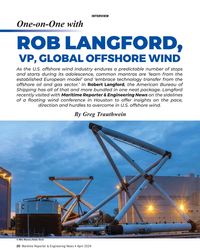 )
April 2024 - Maritime Reporter and Engineering News page: 20
)
April 2024 - Maritime Reporter and Engineering News page: 20INTERVIEW One-on-One with ROB LANGFORD, VP, GLOBAL OFFSHORE WIND As the U.S. offshore wind industry endures a predictable number of stops and starts during its adolescence, common mantras are ‘learn from the established European model’ and ‘embrace technology transfer from the offshore oil and gas
-
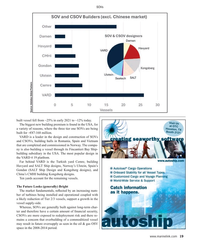 )
April 2024 - Maritime Reporter and Engineering News page: 19
)
April 2024 - Maritime Reporter and Engineering News page: 19SOVs Source: Intelatus Global Partners built vessel fell from ~25% in early 2021 to ~12% today. Visit Us The biggest new building premium is found in the USA, for at OTC Houston, TX a variety of reasons, where the three tier one SOVs are being Booth 2121 built for ~€87-168 million. VARD is a leader in
-
 )
April 2024 - Maritime Reporter and Engineering News page: 18
)
April 2024 - Maritime Reporter and Engineering News page: 18MARKETS & gas activity returns, we anticipate that supply of the vessels The Question of Emissions to offshore wind projects will reduce, driving demand for ad- Given that SOVs and CSOVs operate in a segment target- ditional CSOVs. ing reduced emissions, and many operate in the North Eu- Outside of China
-
 )
April 2024 - Maritime Reporter and Engineering News page: 17
)
April 2024 - Maritime Reporter and Engineering News page: 17SOVs China, we do not look at demand for SOVs/CSOVs as having a linear rela- tionship to the number of wind farms or turbines installed. We look to see where a large number of wind turbines are concentrated in relatively close proximity, generally in a very large wind farm or in a project cluster
-
 )
April 2024 - Maritime Reporter and Engineering News page: 16
)
April 2024 - Maritime Reporter and Engineering News page: 16MARKETS SOVs – Analyzing Current, Future Demand Drivers By Philip Lewis, Director of Research, Intelatus © Björn Wylezich/AdobeStock t a high-level, there are three solutions to transferring Lower day rate CTVs are often used for daily transfer of technicians from shore bases to offshore wind farms
-
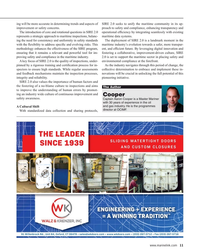 )
April 2024 - Maritime Reporter and Engineering News page: 11
)
April 2024 - Maritime Reporter and Engineering News page: 11ing will be more accurate in determining trends and aspects of SIRE 2.0 seeks to unify the maritime community in its ap- improvement or safety concerns. proach to safety and compliance, enhancing transparency and The introduction of core and rotational questions in SIRE 2.0 operational ef? ciency by
-
 )
April 2024 - Maritime Reporter and Engineering News page: 10
)
April 2024 - Maritime Reporter and Engineering News page: 10Maritime Safety © Roman/AdobeStock SIRE 2.0: Navigating the New Horizon of Maritime Safety By Captain Aaron Cooper, Programs Director, OCIMF he maritime industry is on the cusp of a signi? cant preparing vessel operators and vessel assurance teams for the transformation with the launch of the Ship
-
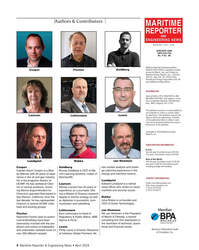 )
April 2024 - Maritime Reporter and Engineering News page: 4
)
April 2024 - Maritime Reporter and Engineering News page: 4Authors & Contributors MARITIME REPORTER AND ENGINEERING NEWS M A R I N E L I N K . C O M ISSN-0025-3448 USPS-016-750 No. 4 Vol. 86 Maritime Reporter/Engineering News (ISSN # 0025-3448) is published monthly Cooper Fischer Goldberg except for March, July, and October by Maritime Activity Reports, Inc.
-
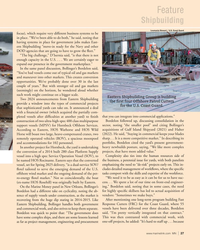 )
April 2024 - Marine News page: 27
)
April 2024 - Marine News page: 27Feature Shipbuilding Loumania Stewart / U.S. Coast Guard focus), which require very different business systems to be in place. “We’ve been able to do both,” he said, noting that having systems in place for government jobs makes East- ern Shipbuilding “move-in ready for the Navy and other DOD agencies
-
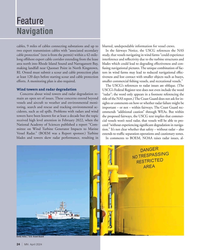 )
April 2024 - Marine News page: 24
)
April 2024 - Marine News page: 24Feature Navigation cables, 9 miles of cables connecting substations and up to blurred, undependable information for vessel crews. two export transmission cables with “associated secondary In the fairways Notice, the USCG references the NAS cable protection” (text is from the permit) within a 42-mile-
